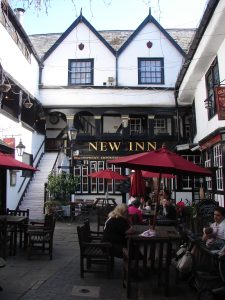My last blog posting continued a discussion of surviving medieval buildings in the city of Gloucester. It focused on the medieval monasteries in Gloucester other than the Abbey of Saint Peter which I discussed in an earlier posting. Gloucester in 1392 is the setting for my third novel in the Lady Apollonia West Country Mysteries Series, Momento Mori, so please join me as we consider other medieval buildings which still stand in Gloucester.
We begin with two parish churches, the first of which is Saint Mary de Lode, shown above. It is also known as Saint Mary Before the Gate of Saint Peter because of its location just west of Saint Mary’s Gate of the Abbey of Saint Peter. This is the gate through which my heroine entered the abbey grounds when she visited the abbey church. The picture you see above is the view she would have had when she exited the abbey grounds through this gate.
We can see that the tower of Saint Mary de Lode Church is ancient Norman architecture while the chancel is 13th century Gothic. Its earlier history is less certain, but legend suggests that a local king was buried on this site in the 2nd century, the first Christian church in Britain. The word “Lode” in the name of the church refers to a water course or ferry and may go back to a time when there was an east branch of the River Severn which passed near this site.
 Another parish church shown above on the left, Saint Mary de Crypt, also plays a role in Memento Mori. One of my villains, Sherf, was married on the porch of this church before departing to live in Cornwall at the end of the novel.
Another parish church shown above on the left, Saint Mary de Crypt, also plays a role in Memento Mori. One of my villains, Sherf, was married on the porch of this church before departing to live in Cornwall at the end of the novel.
Another surviving ancient building is The New Inn on Northgate Street. It is shown on the lower right and is a fine example of a medieval courtyard inn with galleries. In our day, the New Inn has a restaurant, pub, coffee shop, hotel with 36 rooms, and two function rooms Although the present building dates from half a century after my novel, it was built on the site of an even older inn and provided me with a living example of a medieval inn that was in business in Gloucester during the fourteenth century.
The last building, shown below. is on Westgate Street, and, like the New Inn, was built after 1392 when Memento Mori is set. When I was last in Gloucester doing research for my story, this ancient building had become The Gloucester Folk Museum. However, it served as my inspiration for Windemere House, the grand home in my story of Lady Apollonia and her third husband, Richard Windemere.
 Please join me for future posts as we prepare to discuss a great “pandemic” of the fourteenth century: the bubonic plague.
Please join me for future posts as we prepare to discuss a great “pandemic” of the fourteenth century: the bubonic plague.

